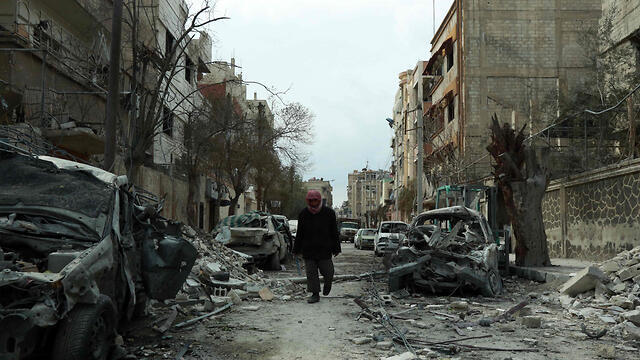Getting your Trinity Audio player ready...
Many people had their hopes pinned on the eradication of the Islamic State (ISIS) in Syria, assuming that once the goal is reached, the war in the country would come to an end.
But the Syrian reality points to an opposite trend: old rivalries between the players that enlisted to fight ISIS—the United States, Russia, Iran, the Assad regime, Turkey and the Kurds—are taking center stage again.
The process for an agreement in Syria was promoted on three different diplomatic channels: in Astana—led by Russia, Iran and Turkey—in Geneva—led by the United Nations—and in Sochi—led by Russia—and neither bore any fruit.
Seeing that the military and diplomatic agreement is stuck, the Syrian regime is brutally bombing areas held by the opposition. President Bashar Assad and his partners keep carrying out horrific acts even more intensely against rival organizations, particularly within a civil population—this time in the Ghouta area, east of Damascus.
2 View gallery


Destruction in Ghouta. Sadly, the world has gotten used to this situation
(צילום: AFP)
Sadly, the world has gotten used to this situation and chooses to stand aloof, turn its head away and accept the violation of Security Council resolutions about a ceasefire .
Developments are now on the regional and international levels. In the past month, countries and world powers have been going head-to-head, waging direct battles. So instead of the conflict dying down and being regulated, we are witnessing an escalation with the potential of expanding into a direct international conflict—rather than merely a proxy war—while igniting some old-new fronts:
US-Russia: In a clash between American forces and Assad regime forces, which tried to cross the Euphrates River in the east, Americans killed some 300 enemy combatants, including Russian “mercenaries.” The incident was denied and silenced in Russia, but the argument that the US presence in Syria is no longer legitimate after ISIS’s defeat made a huge impact.
The report about the deployment of Russia’s modern stealth aircraft in Syria is also advancing a clear agenda against the US presence there. Moreover, it is challenging other armies in the region, particularly the IDF, and raising questions about the prospect of preventing an Israeli-Russian clash in Syrian skies.
Another cause of tension between Washington and Moscow is the American declarations about a future response following the Assad regime’s chemical weapon attacks .
2 View gallery


US Ambassador to the UN Nikki Haley votes for a ceasefire resolution in Syria
(צילום: EPA)
Turkey-Russia: Turkey has been involved in Syria since the beginning of the fighting in the country, mostly indirectly. Ankara’s demand to dismiss Assad was rejected both by Tehran and by Moscow. The establishment of an autonomous Kurdish district in Afrin—an area controlled by PYD, a Kurdish organization affiliated with the Turkish-Kurd PKK party, which is listed as a terror organization in Turkey—was seen as a red line by the Turks, who invaded Syria in early February as part of Operation Olive Branch .
An interesting turn of events took place when the Kurds received assistance from Assad regime forces, their bitter rivals throughout years of fighting. Now, they are protecting Syrian territory together against the Turkish invasion.
US-Turkey: A potential conflict between two NATO members. a Kurdish-Arab army led the victory over ISIS, with US help, in the Kurdish district east of the Euphrates River. Here, too, the Turks are concerned about the establishment of a Kurdish autonomous region on their southern border. They are threatening to invade it and are expected to clash with the American forces that have remained in the area to support the region’s reconstruction.
Israel-Iran: The day of fighting on February 10 demonstrated the potential for an Israeli-Iranian clash in the northern arena, involving Syria and Hezbollah. Iran’s determination to keep entrenching itself in Syria, and Israel’s determination to stop it, are dangerously explosive, especially once the Assad forces and Tehran begin to restore their rule in the southern Syrian Golan Heights, and of course if the Iranians fulfill their intention to build an industry of precision-guided ballistic missiles in Syria and in Lebanon.
All the forces of power in Syria—both the internal and the external ones—have proved recently that they are willing to get to the verge and go way beyond it: To use military force, to ignore UN resolutions and mediation and stabilization efforts and to keep trying to promote their interests.
In a battle with so many players who are willing to act directly against their rivals, 2018 doesn’t mark the end of the war in Syria. It’s the beginning of another dangerous chapter in the tragedy taking place on our northern border.
Major-General (res.) Amos Yadlin is the director of Tel Aviv University’s Institute for National Security Studies (INSS) and served as head of the IDF's Military Intelligence Directorate.

